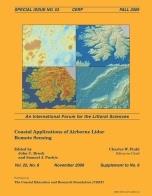Special Issue 54 - Geologic and Environmental Dynamics of the Pontchartrain Basin [FitzGerald & Reed]
DEPARTMENTS (1)
COVER PHOTOGRAPH (1)
LETTER (1)
ACKNOWLEDGEMENTS (1)
PREFACE (2)
RESEARCH ARTICLES (19)

No abstract available
No abstract available
No abstract available
No abstract available
No abstract available
No abstract available
